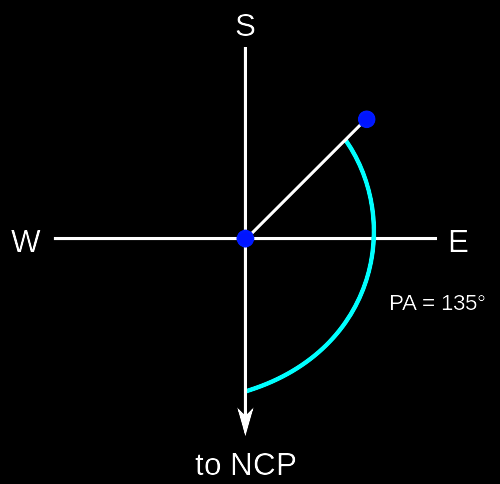There is a convention for measuring angles on the sky, and it’s called Position Angle. Quoting the Position Angle article from Wikipedia (bold is mine):
“In astronomy, position angle (usually abbreviated PA) is the convention for measuring angles on the sky. The International Astronomical Union defines it as the angle measured relative to the north celestial pole (NCP), turning positive into the direction of the right ascension. In the standard (non-flipped) images, this is a counterclockwise measure relative to the axis into the direction of positive declination.”
Please note, this is independent of which hemisphere you are located in, your current setup, if your telescope shows an inverted image, if you did a meridian flip, if your camera is rotated to one side of the other, etc. The angle is defined solely based on where the NCP is - and, thus, where East is.
Check the following image, also from Wikipedia, in which we can see a couple of things:

- The North Celestial Pole is down (as it would appear if you were in the Southern hemisphere).
- If you rotate this image so the NCP is up, you’ll see East is left instead of the usual right we see on all terrestrial maps. On the sky, East is left of North because you are seeing the celestial sphere “from the inside”, as opposed to the Earth sphere that we see/experience from the outside.
- The Position Angle is always measured to the East.
In Telescopius Telescope Simulator, the NCP is always up, so East is left. When your framing is not rotated (let’s call this scenario A), the top of the frame “points” to the NCP. You can imagine a perpendicular line coming from the top of your image towards the NCP. As you increase the PA, your frame is rotated counter-clockwise, and so the perpendicular line is “tilted” to the left (scenario B). The PA is the exact angle between both imaginary perpendicular lines in scenarios A and B.
–
Having said that, I’ve found many great pieces of software showing the opposite PA - West of North - which made me revisit this definition to try and get it right on Telescopius. In fact, here is a thread I opened to discuss this issue almost 3 years ago on the Astrometry.net discussion group because I was going crazy trying to figure out if Telescopius was right or not. I even created some example pictures by rotating and flipping the image to see what was going on with the plate solved PA: https://groups.google.com/g/astrometry/c/glVFictwNV4/m/wktcUMc_BgAJ
That thread ends with a link to another discussion opened 1.5 years before that, where the issue is discussed too and they asked to add a North arrow in the annotated images to get rid of any confusion: Feature request: add a North/East arrow to annotated images · Issue #151 · dstndstn/astrometry.net · GitHub. In both cases, the conclusion is that Astrometry.net is showing a PA West of North instead of East of North. I can only guess that the applications showing a PA inverted when compared to the IAU convention have probably not taken into account that East is left in the sky instead of right. But that’s just my guess.
In contrast, other systems like the ones used in iTelescope or Insight Observatory automated systems, actually match the PA shown on Telescopius. They are using the standard definition of PA, that’s East of North.
I hope this sheds some light into this issue and helps others with the same doubt.